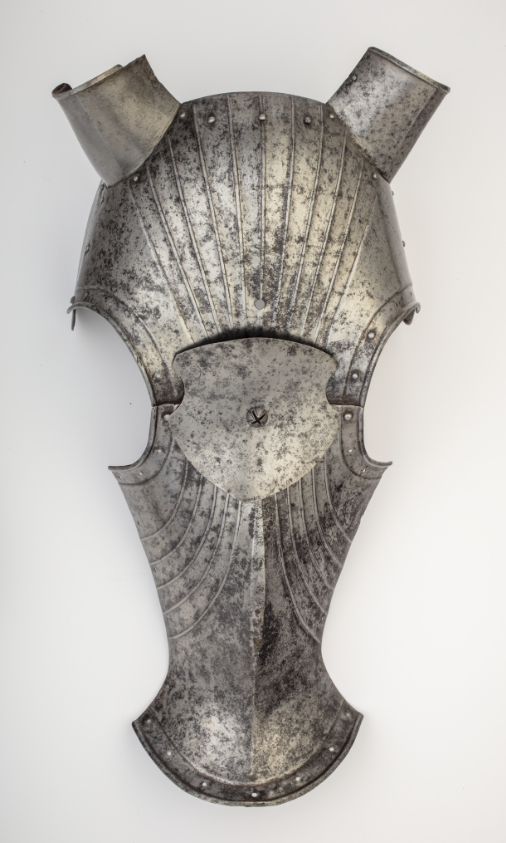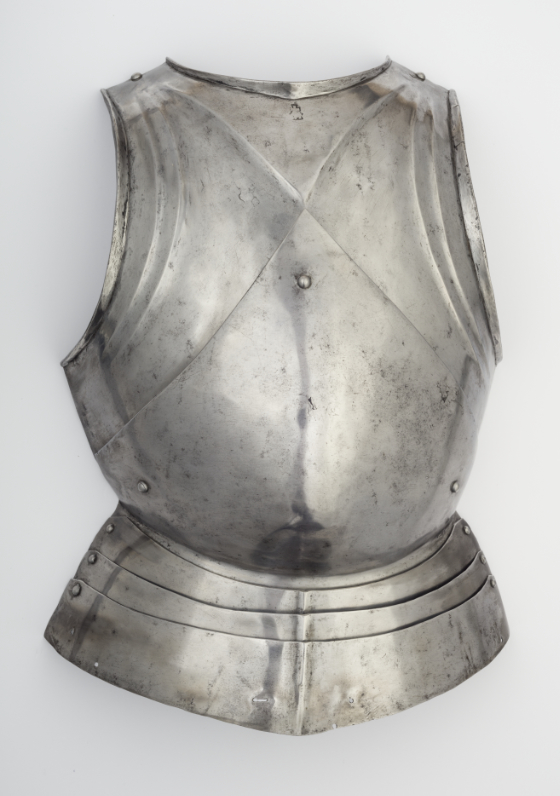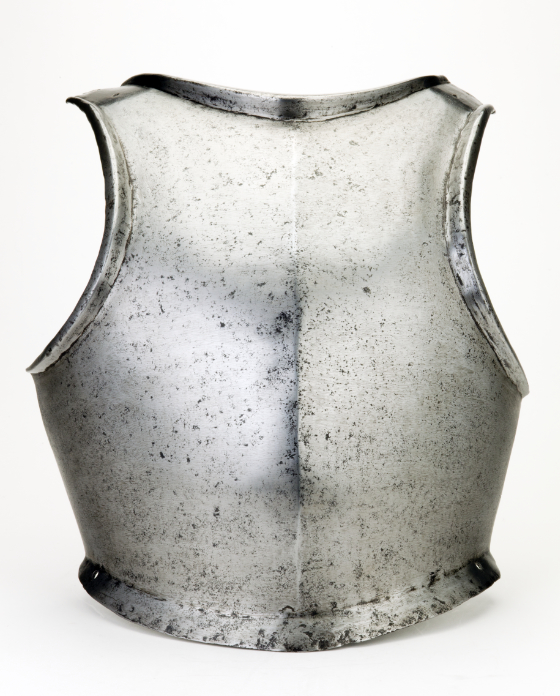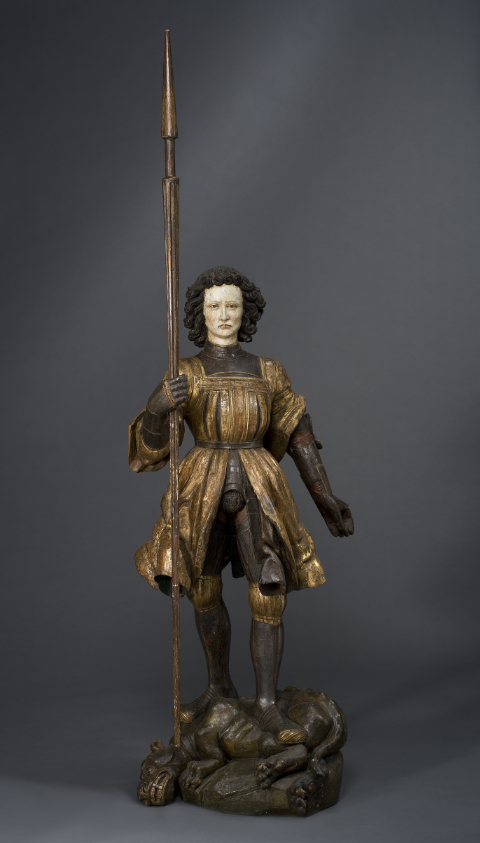Armor often reflected the height of civilian fashion of the time. Early forms were covered with fabric, either as a separate overgarment or as a supporting shell for steel plates. During the Renaissance, armor was often left uncovered to display the fine metalworking.
Armor made with fluted metal surfaces mimicked the pleated fabrics of garments from the late 1400s and early 1500s, while etched and gilt decoration imitated richly patterned fabrics and decorative trim found on fashionable clothing of later periods. Even as armor’s effectiveness for defense declined, armor continued to be worn for ceremonial purposes as a fashion statement in its own right.
Maximilian-Style Field Armor
Southern Germany
About 1525–30
Steel and leather with modern restorations
Weight 64 lbs. 14 oz.
The John Woodman Higgins Armory Collection, 2014.111
Image © 2021 Worcester Art Museum, all rights reserved
Warhammer for a Horseman
Probably Augsburg, southern Germany
About 1525–30
Etched and heat-blackened steel
Weight 2 lb. 12 oz.
The John Woodman Higgins Armory Collection, 2014.469
Image © 2021 Worcester Art Museum, all rights reserved
Named for Maximilian I, ruler of the Holy Roman Empire in the early 1500s, Maximilian armor reflected civilian fashion. The fluted surfaces mimic the pleats of contemporary garments and may have strengthened the metal. The smooth armor on the lower leg imitates silk stockings, and the broad-toed sabatons echo the shape of fashionable men’s shoes. Armor in this style was time-consuming to produce, and by the mid-1500s, it had given way to new styles that followed changing fashion tastes.

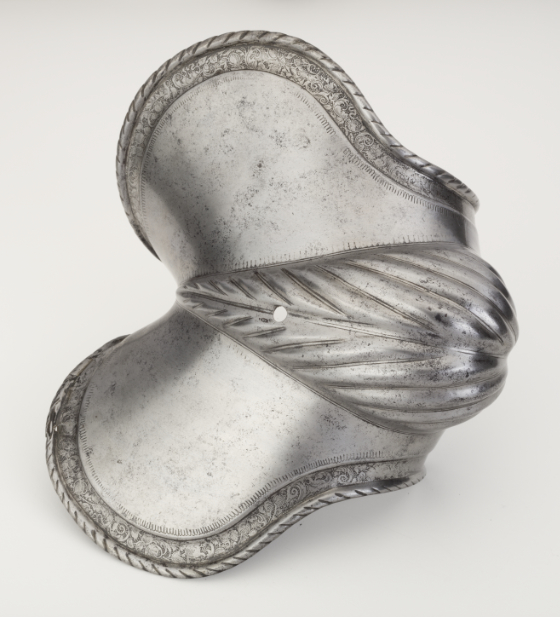
Maximilian-Style Breastplate and Fauld
Probably Milan, northern Italy
About 1510–15
Steel with etching from the 1800s
Weight 7 lb. 2 oz.
The John Woodman Higgins Armory Collection, 2014.806.3
Image © 2021 Worcester Art Museum, all rights reserved
Maximillian-Style Cowter for the Left Elbow
Southern Germany
1530–40
Etched and heat-blackened steel
Weight 2 lb. 8 oz.
The John Woodman Higgins Armory Collection, 2014.1138.5
Image © 2021 Worcester Art Museum, all rights reserved
Maximillian-Style Horse’s Head Armor (Shaffron)
Southern Germany
About 1520
Steel
Weight 3 lb. 2 oz.
The John Woodman Higgins Armory Collection, 2014.16
Image © 2021 Worcester Art Museum, all rights reserved
Angles and Curves
Master IA
Italian, active in Milan, late 1400s
Infantry Breastplate
About 1480
Steel
Weight 6 lb. 4 oz.
The John Woodman Higgins Armory Collection, 2014.50
Image © 2021 Worcester Art Museum, all rights reserved
Breastplate
Probably Italy
About 1500–10
Steel
Weight 5 lb. 5 oz
The John Woodman Higgins Armory Collection, 2014.760
Image © 2021 Worcester Art Museum, all rights reserved
Northern Italy was a main center for armor-making, and artisans catered to both German and Italian markets. The angular lines and ribbed decoration on the more elaborate breastplate are typical of the Gothic style popular in Germany in the late 1400s. Its rounded profile and rippling at the arms imitate the look of a man’s civilian jacket. Made for the German market, it ended up in the armory of the counts of Churburg in South Tyrol. By contrast, the plain breastplate exemplifies the restrained sculptural style favored by the Italian armor market.
Circle of Hans Leinberger
German, active in Bavaria, late 1400s–early 1500s
Saint George and the Dragon
About 1525
Wood with applied color
Denver Art Museum: Gift of the Samuel H. Kress Foundation, 1963.107A-B
Saint George is a Christian saint typically shown wearing military attire and defeating a dragon. Here the saint’s armor is in the Maximillian style, with its characteristic ridges just visible beneath a garment called a surcoat. Such covering garments allowed knights to display personal insignia for identification. This example has stylish slashes at the chest, an element popular in clothing of the 1500s, that reveal the armor beneath.

Age of Armor: Treasures from the Higgins Collection at the Worcester Art Museum is organized by the Worcester Art Museum. Support is provided by the donors to the Annual Fund Leadership Campaign and the residents who support the Scientific and Cultural Facilities District (SCFD). Promotional support is provided by 5280 Magazine and CBS4.

